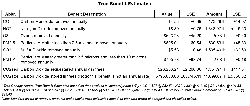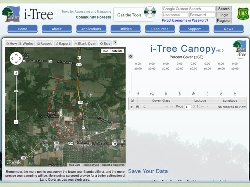Tree Canopy at WIU Provides $800K+ of Value for Campus Community
April 18, 2014

Fall 2013 at Western Illinois University's Lake Ruth. According to Paul Blome, an urban forestry instructor in the WIU School of Agriculture, the tree "canopy" at Western provides a value of somewhere around $830,000 in pollution reduction alone.
[Download Print-Quality Image]
MACOMB, IL – The beautiful trees spread across Western Illinois University's Macomb campus do more than just increase the aesthetics of the University grounds. According to Paul Blome, an urban forestry instructor in the WIU School of Agriculture, the tree "canopy" at Western provides a value of somewhere around $830,000 in pollution reduction alone.
As an urban forestry expert, Blome is well aware of the sightly advantages and the environmental benefits trees provide. He noted, though, up until recently, it "has been difficult to make people aware of the dollar value of the multitude of benefits trees provide."
So, this semester, using a free USDA Forest Service suite of software tools called "i-Tree," he and students in his urban forest management course (FOR 407G) set out to do just that. They worked with Chad Sperry, the director of Western's GIS Center, to determine campus boundaries and ultimately used a map of campus that included the School of Agriculture's University Farm, as well as the Harry Mussatto Golf Course.
"With the i-Tree Canopy program, you can determine the amount of tree canopy covering any given plot of land you delineate," Blome explained. "The software randomly generates sample points on campus, and we evaluated each point as tree canopy or not tree canopy, and i-Tree Canopy used the data to come up with a monetary value of the trees' pollution-reduction benefits to the community. Part of these benefit values are attributed to improved health of residents. If the trees did not help clean our air, more people would need to seek medical attention for respiratory problems, there would be increased respiratory sickness, increased emergency room visits (asthma attacks, etc.) and lost work days. The cost of all these health impacts add up to a lot of money," he explained.
According to Blome, benefits of Western's tree canopy also include carbon dioxide sequestration (reduced Greenhouse Effect and Urban Heat Island Effect), energy savings (reduced heating and cooling costs) and shade cover for people enjoying or working in the outdoors.
"The tree canopy at WIU covers about 35 percent of the footprint, or surface area, of campus. Using i-Tree Canopy, we found trees on campus provide about $26,000 worth of annual benefits to people in the area. If you include how much carbon has been sequestered in the wood of all the trees over the time they have been growing here, that totals to about $800,000 worth of carbon tied up inside the trees. So we're looking at close to $830,000 worth of value for the community from these trees in just pollution reduction," Blome added.
Blome said his FOR 407G students—including Justin Bourquin (Lena, IL), sophomore; Sam Kipling (Macomb, IL), freshman; Shelby Miller (Rock Falls, IL), senior; Narissa Orwig (Canton, IL), senior; and Garrett Whitehurst (Yates City, IL), junior—recently presented a report of their findings to Western's Tree Advisory Committee, which he co-chairs with Tara Beal, the superintendent of landscape maintenance on campus. The tree advisory committee, Blome noted, is the body that's partly responsible for Western achieving the Tree Campus USA designation for the second year in a row (see "WIU Arbor Day Celebration April 25 Celebration" at www.wiu.edu/news/newsrelease.php?release_id=11598.)
Last year, Blome and some of his urban forestry students were also involved in an effort to educate Western's campus community about the value of trees. Just before Arbor Day, they began a tree-tagging project on campus, for which they used large "price" tags and attached them to several trees to show the dollar-amount benefit each tree provides to the community annually. They plan to do it again this year, and he said they will be placing the tags on trees next week, before the University's 2014 celebration of Arbor Day, Friday April 25.
"You can go online and search 'tree benefit calculator' to find software that will help anyone make a simple estimation of a tree's environmental benefits to the people and animals who live there," he explained. "Once you find the website, you just put in the tree species and the DBH, or 'diameter at breast height,' and your zip code, and it will produce a list of various benefits that this one tree will offer (in pollution reduction, property value increases, etc.)."
For more information about the i-Tree project and/or the tree tag project, contact Blome at (309) 298-1160 or via email at PH-Blome@wiu.edu. For more information about the Arbor Day 2014 Celebration, contact Beal at TS-Beal@wiu.edu.
Posted By: Teresa Koltzenburg (WIUNews@wiu.edu)
Office of University Communications & Marketing



Connect with us: